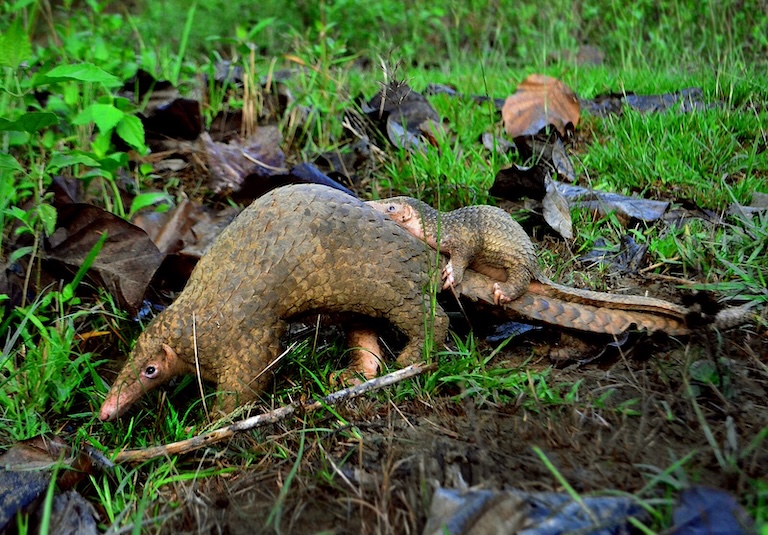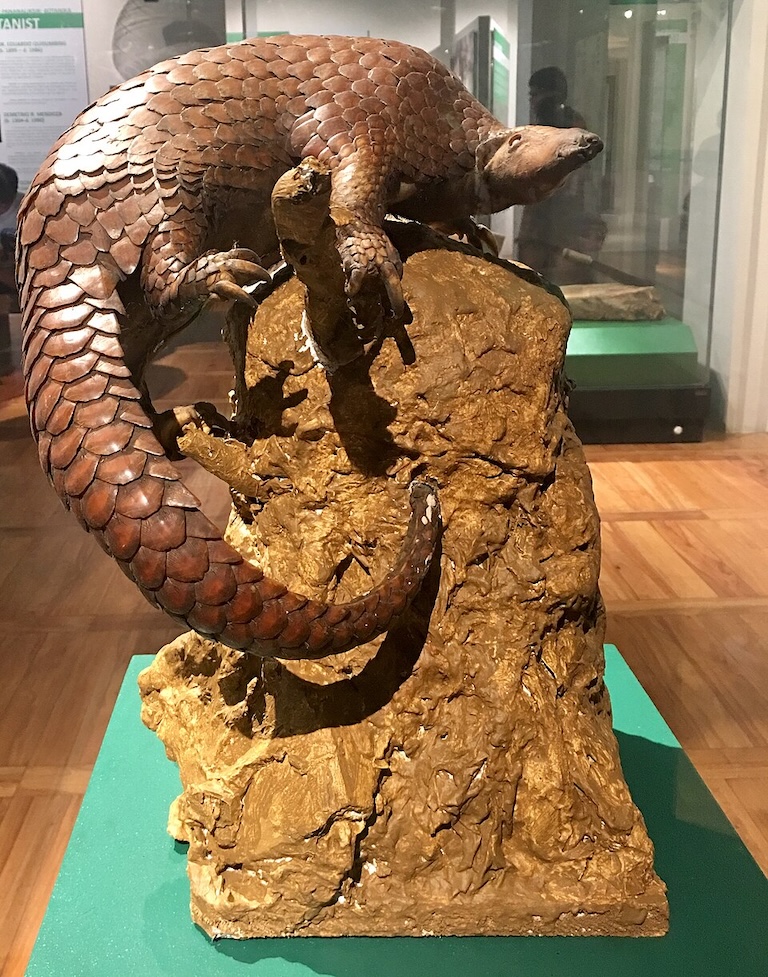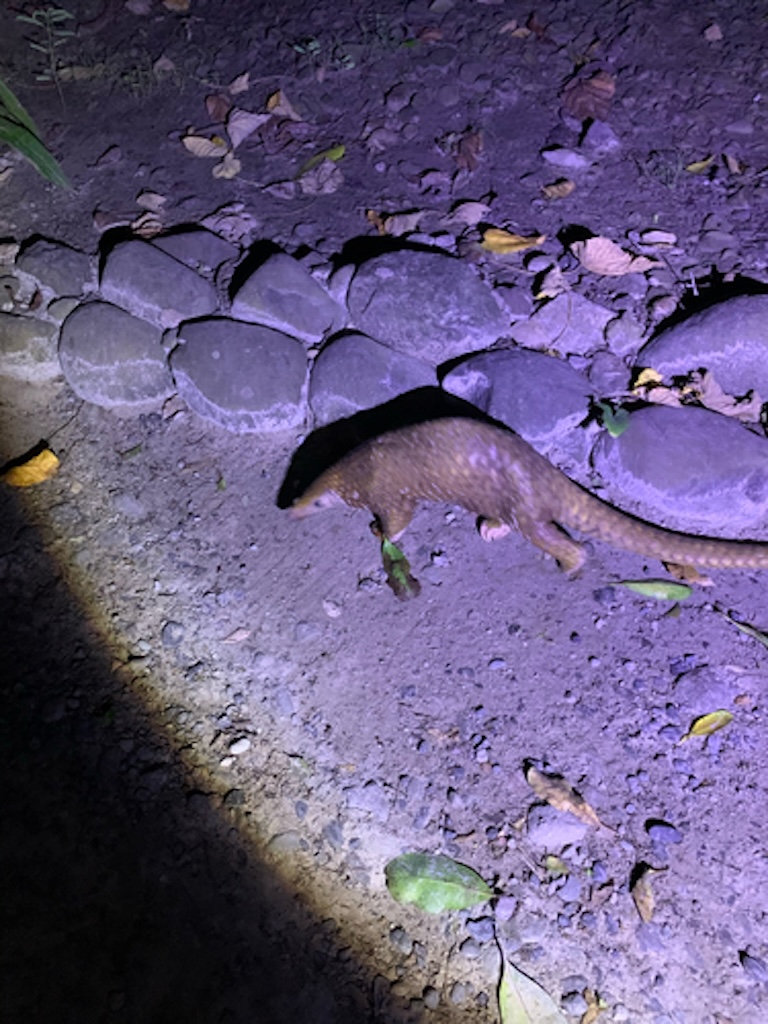Philippine Pangolin Profile
Scientifically regarded as “Little cuties”, pangolins are some of the least deserving of the trouble they face, keeping mostly, as they do, to themselves.
But this secretive life comes back to bite them in the scales when rampant “over-harvesting” of the animals can’t be met with any informed conservation efforts due to a conspicuous lack of scientific knowledge.
Sadly, one of the worst hit is the Philippine pangolin, a critically endangered species still hunted for the magical properties that its meat, blood and scales definitely don’t have.

Philippine Pangolin Facts Overview
| Habitat: | Lowland forests, grasslands, agricultural areas; arboreal and terrestrial |
| Location: | Philippines |
| Lifespan: | Unknown |
| Size: | Up to 1.8 m (6 ft) long |
| Weight: | Up to 2.4 kg (5.3 lb) |
| Colour: | Sandy brown |
| Diet: | Almost exclusively ants and termites |
| Predators: | Pythons and humans |
| Top Speed: | Slow |
| No. of Species: | 1 |
| Conservation Status: | Critically endangered |
One of the biggest hindrances to Philippine pangolin literature is that it wasn’t even recognised as a separate species until recently.
Like all pangolins, it’s thought to burrow, eat ants, and squirt unpleasant things out of its backend when afraid (don’t we all?) but this one is more arboreal than some and stays out of the way of researchers very well.
Unfortunately, local hunters know how to find it, and an increasing demand from pompous elites in China is making it so that the species may not last much longer.
Interesting Philippine Pangolin Facts
1. They’ve only recently been recognised
Aside from being little cuties, very little is known about Philippine pangolins for a whole bunch of reasons.
Not least, because they spread out thinly across the land and are therefore found in very low densities, but mostly because they were thought to be the same species as another population of pangolins found in Java.
This species wasn’t even considered a species until 1998, when its position as a subspecies of the Javan pangolin was properly discussed, leading to its placement into its own distinct species in 2005.
So, this is essentially a new animal to science, and much more research is needed to fill the historical gap. 1

2. They’re Forest specialists
Philippine pangolins are expert climbers, and while they don’t move very fast, their strong claws and prehensile tails allow them to traverse the canopy easily.
They prefer both primary and secondary lowland forests, but are adaptable to other environments, too, and will be found on the ground sometimes, in agricultural land, and even moving into urban environments as their forest habitats are reduced.
There have been no specific studies on habitat preferences for this species, but assumptions can be made from other research and from looking at the similar species in Java. One of the reasons there’s not much to go on is due to their habit of hiding away all day and only coming out at night.
It’s likely that pangolins pick their favourite habitats based on how many termites and ants there are available to suck down, which is something these animals love to do. Mostly at night.
3. They’re nocturnal
This animal is already borderline mythical simply for being a scaled mammal, but its elusive and nocturnal nature means there are countless mysteries about it yet to be revealed.
One cool little mystery is whether or not they follow the lunar calendar. It seems in other pangolin species that they’re more active during full moons when they’re found more often on the ground than usual.
They forage almost entirely at night, eating ants and termites from the canopy and the ground, and burrowing into the earth for safety to hide out during the day.
4. They have no teeth
As if the scales weren’t enough to make this weird animal interesting, the Philippine pangolin can run on its hind legs when it has to.
Generally slow animals, their main defence method is to curl into a ball and spray butt water at a pestering threat, and while they do have enormous and powerful claws, these are only used for digging.
Digging into a termite mound reveals gazillions of tiny snacks, none of which actually need to be chewed, which is handy, because the pangolins don’t have teeth. Instead, they have a tongue that’s almost a foot long, and saliva that’s more like wood glue.
Shooting this sticky appendage into a termite hole retrieves plenty to suck down, and their long, triangular snout is part of this. But having a long snout is also all the better to smell you with.
5. They have incredible noses
Pangolins are often called scaly anteaters, which is literally what they are, but taxonomically inaccurate. Anteaters are members of the sloth order Pilosa, while pangolins are more closely related to the Carnivorans, and make up the order Pholidota.
But while the two aren’t related, they do have a lot of similarities, owing to the fact they both use similar survival strategies. Shuffling around, breaking open ant hills and sucking up the inhabitants, the two groups have evolved to be very alike, but entirely independently.
Like anteaters, pangolins have terrible eyesight. Ants, too, don’t see that well, and communicate by smell, leaving pheromone trails behind them for their kin, and these trails are picked up by the extremely well-tuned olfactory senses of the pangolin.
This sense of smell appears to have evolved rapidly in pangolins but is still being investigated, and research suggests that it might play a big role in their secret lives, being that they don’t make a lot of sounds and rarely come all that close to one another.
One key factor in pangolin communication comes from the other end. 2
6. They talk out of their arses
Pangolins have anal glands that function much like the defence mechanism of a skunk and spray both predators and well-intentioned rescuers with smelly butt juice. But they are likely able to use these smelly signals to leave messages for one another, too.
As researchers rush to tease out as much information as they can from these secretive animals, their days are numbered, and the poor pangolins are now almost extinct.

7. Demand for their products is increasing
In a healthy culture, as a species approaches extinction, demand for its massacre would drop significantly.
Unfortunately, there’s nothing healthy about the culture of Chinese traditional medicine, least of all many of the “cures” which are often empty placebos at best and dangerous treatments with unforetold side effects at worst.
When stripped of the corruption that financial incentives of Big Pharma bring into it, medicine is, at its heart, a scientific practice of identifying, quantifying and homogenising doseable effective ingredients into safe and efficacious treatments.
While alternative medicines may contain effective ingredients (though they often don’t), without the rigour of the scientific method, nobody knows how much they contain, whether they’re safer than current treatments, or what else they bring along with them.
But practitioners of traditional medicine don’t care for all that. And as the progressive, critical world continually debunks exaggerated and false claims by one, these facts are rejected in favour of what feels right. And animals like the Philippine pangolin are collateral damage.
While this species is hunted for subsistence and fake medicine by natives of the Philippines, too, the larger driver of its decline today doesn’t come from a national market, instead, it comes from China, where its scales are used as a reagent in traditional East Asian medicine and to treat asthma – a condition that is already perfectly treatable with modern medicine that actually works.
Even more, the meat is prized as a signifier of social status by people who love to eat things that are about to go extinct, and this market increases the demand for the animal with each step closer to extinction.
Ultimately, pangolin products are increasing in value as the demand rises, and the species disappears. It is an unconscionable and backwards process that has no place in the natural world. 3 4
8. They’re running out of space
In a pincer manoeuvre with illegal hunting, habitat destruction is closing in on the Philippine pangolin. Deforestation is leaving it nowhere to hide, and it is increasingly found in urban environments as a result, making it all that much easier to hunt.
In 2008, they were listed as Near Threatened by the IUCN. In 2019 they jumped to Critically Endangered. It is a matter of urgency for researchers to get a better understanding of this animal that conservationists can use to help protect them.
Meanwhile, it’s also important to spread the truth about ‘alternative medicine’ to help reduce the implied acceptance of such destructive and misguided practices overall.
Philippine Pangolin Fact-File Summary
Scientific Classification
| Kingdom: | Animalia |
| Phylum: | Chordata |
| Class: | Mammalia |
| Order: | Pilosa |
| Family: | Manidae |
| Genus: | Manis |
| Species: | culionensis |
Fact Sources & References
- Andrew Helmsworth, “Manis culionensis Philippine pangolin”, Animal Diversity Web.
- Jun Li (2024), “Genomic signatures of sensory adaptation and evolution in pangolinsCe Guo,” BMC Geonomics.
- “Philippine Pangolin”, IUCN Red List.
- “PALAWAN PANGOLIN (Manis culionensis) CONSERVATION STRATEGY 2018-2043”, ZOOLOGICAL SOCIETY OF LONDON .
